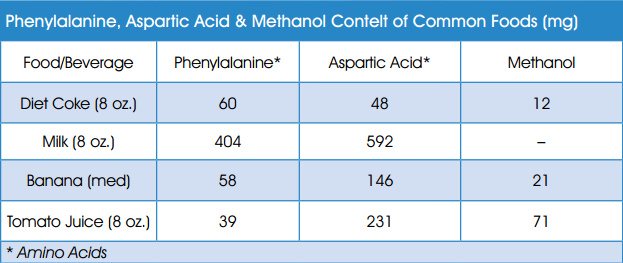Aspartame is one of six non-nutritive sweeteners and one of five artificial sweeteners approved by the FDA. The name is derived from aspartic acid, one of 2 amino acids – the other being phenylalanine – that aspartame is mostly composed of. It is the third oldest known sugar substitute – saccharin and cyclamate before it – dating back to its discovery in 1965 by James Schlatte. Today, aspartame is in over 6,000 food and beverage products and approved for use in over 100 countries. [9]

It all started when Schlatte, a researcher working at the pharmaceutical company G D Searle, was looking for a treatment for ulcers by working with amino acids. He licked his finger to pick up a piece of paper and got the first taste of aspartame. The sweetener is listed as being 180 to 200 times sweeter than sucrose with a clean taste that is desirable among consumers. [1] It can enhance fruit flavors, saves calories, and does not contribute to tooth decay. [2]
The FDA has set the ADI for aspartame at 50 mg/kg of body weight per day. This is the highest ADI of any of the six non-nutritive sweeteners, with the other five ranging from 0 to 15 mg/kg of body weight per day. Aspartame consumption by high-level consumers in the general population is between five percent and 10 percent of the ADI. [PDF]
Unlike saccharin, a coal-tar derivative, the amino acids in aspartame are already found in other foods. The calorie control council states, “A serving of nonfat milk provides about 6 times more phenylalanine and 13 times more aspartic acid compared to an equivalent amount of diet beverage sweetened 100% with aspartame. Likewise, a serving of tomato juice provides about 6 times more methanol compared to an equivalent amount of diet beverage with aspartame.” Methanol is metabolized into formaldehyde, which the liver quickly and safely removes from the body. [8]
Before it was approved, “aspartame underwent one of the most rigorous testing programs and thorough regulatory reviews in food ingredient history.” [3] Since 1967, aspartame is said to have had more than 200 scientific studies conducted on laboratory animals, men, women, and children. “More than 100 toxicological and clinical studies the agency has reviewed confirm that aspartame is safe for the general population.” [5] In 1981, the FDA approved aspartame for use in tabletop sweeteners and various foods and dry beverage mixes. In 1983, it was approved for use in carbonated beverages. Over the next 13 years other products would be approved to use aspartame. This led to aspartame’s general approval for foods and beverages in 1996. [4]
The breakdown of aspartame’s components – aspartic acid, phenylalanine, & methanol – have been questioned as having harmful effects, yet have no scientific proof. [6] EFSA, the European Food Safety Authority, made a statement (PDF) on two scientific studies that suggested aspartame – in doses upwards of 4,000 mg/kg – may contribute to some blood-related cancers in rats. The statement found the studies inconclusive and stated that there is no reason to reconsider previous evaluations of aspartame that declared it safe for use.
Plenty more allegations have been made in regard to supposed aspartame side effects. In 1984, the Centers for Disease Control (CDC) reviewed 517 anecdotal reports and stated, “the majority of frequently reported symptoms were mild and are symptoms that are common in the general populace.” Some of the diseases associated with aspartame include multiple sclerosis, Parkinson’s disease, Alzheimer’s disease, and lupus, but there is no scientific evidence to back these claims. [7] In response, “The Multiple Sclerosis Foundation, The National Multiple Sclerosis Society, The National Parkinson Foundation, Inc., the Alzheimer’s Association, and the Lupus Foundation of America, have reviewed the claims on the Internet and also concluded that they are false.” [10]
In 2007, the FDA stated:
“Considering results from the large number of studies on aspartame’s safety, including five previously conducted negative chronic carcinogenicity studies, a recently reported large epidemiology study with negative associations between the use of aspartame and the occurrence of tumors, and negative findings from a series of three transgenic mouse assays, FDA finds no reason to alter its previous conclusion that aspartame is safe as a general purpose sweetener in food.”
However, aspartame continues to be criticized as a dangerous food additive, spawning the creation of sites such as sweetpoison and aspartamekills. The site sweetpoison has listed 92 aspartame-related symptoms that were submitted to the FDA, which were not scientifically proven to be connected to aspartame. Dr. Joseph Mercola has an article criticizing aspartame, calling it the most dangerous substance added to food. Regular bloggers are showing their concern as well. More criticisms can be read here, here, and here.
Aspartame has recently been renamed to AminoSweet and is now being marketed as a natural sweetener, which has a poor taste in some peoples mouths. Other brand names of aspartame are NutraSweet, Equal, Spoonful, and Equal-Measure.
It’s hard to ignore the numerous anecdotal reports from consumers of aspartame, but without scientific evidence the artificial sweetener will continue to be approved by the FDA. If you currently consume aspartame and have faced side affects that may be linked to its use, common sense tells you that it’s in your best interest to stop the use of the product. Feel free to share any personal experiences using aspartame.
Here is the brochure on aspartame that supplied two of the used images above.


Very good post! In my point of view, and according to the research I am conducting, aspartame is definitely no good for our health. We should all stop using it!!
Thanks for the reply, aspartame seems to be one of the ones to definitely stay away from. Hopefully more concrete evidence can get the FDA to remove the approval!